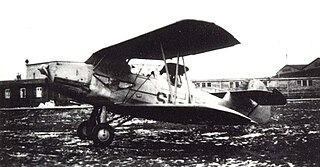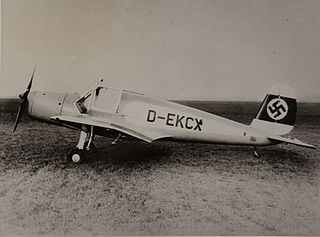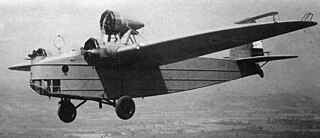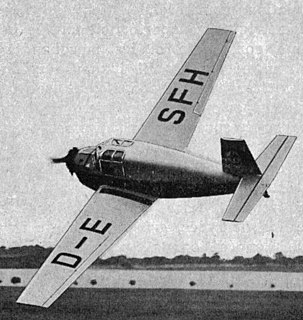
The Focke-Wulf Fw 44 Stieglitz ("Goldfinch") is a 1930s German two-seat biplane. An early design by Kurt Tank, it was produced by the Focke-Wulf company as a pilot training and sports flying aircraft. It was also eventually built under license in several other countries.

The Arado Ar 68 was a German single-seat biplane fighter developed in the mid-1930s. It was among the first fighters produced when Germany abandoned the restrictions of the Treaty of Versailles and began rearming.

The Siebel Si 204 was a small twin-engined transport and trainer aircraft developed in World War II. It was based on the Fh 104 Hallore. Originally designed in response to an Ministry of Aviation development order for a small civil transport aircraft in 1938, it was eventually produced for the Luftwaffe.

The Arado Ar 66 was a German single-engined, two-seat training biplane, developed in 1933. It was also used for night ground-attack missions on the Eastern Front. It was engineer Walter Rethel's last design in collaboration with Arado, before Walter Blume, assigned as Arado Flugzeugwerke's chief design engineer in 1933, took over the bulk of the Arado firm's design duties.

The Argus As 10 was a German-designed and built, air-cooled 90° cylinder bank-angle inverted V8 "low power" aircraft engine, used mainly in training aircraft such as the Arado Ar 66 and Focke-Wulf Fw 56 Stösser and other small short-range reconnaissance and communications aircraft like the Fieseler Fi 156 Storch during, and shortly after World War II. It was first built in 1928.

The Messerschmitt Bf 163 was an STOL aircraft designed by BFW and built by Weserflug before World War II.

The Arado Ar 76 was a German aircraft of the 1930s, designed as a light fighter with a secondary role as an advanced trainer in mind.

The Argus As 410 was a German air-cooled inverted V-12 light aircraft engine that was first produced by Argus Motoren in 1938.

The Arado Ar 79 was a German aircraft of the 1930s, designed as an aerobatic two-seat trainer and touring aircraft.

The BFW M.20 was a German single-engine, high-wing monoplane ten-seat passenger transport aircraft, developed in the late 1920s and early 1930s. Deutsche Luft Hansa used it throughout the 1930s on a variety of routes.

The Dornier Do Y was a German bomber of the 1930s, the second bomber design by Dornier Flugzeugwerke.

The Bayerische Flugzeugwerke M 18, was an airliner, produced in Germany in the late 1920s.

The Blohm & Voss Ha 140 was a German multi-purpose seaplane first flown in 1937. It was intended for use as a torpedo bomber or long-range reconnaissance aircraft but did not enter production.

The Siebel Fh 104 Hallore was a small German twin-engined transport, communications and liaison aircraft built by Siebel.

The Siebel Si 202 Hummel ("Bumble-bee") was a German light sportsplane of the late 1930s. It was an angular low-wing monoplane, which could be powered by a variety of small engines.
The Arado Ar 69 was a two-seat German beginner's school and sport biplane with an open cockpit, developed in 1933 by Arado Flugzeugwerke.

The Arado Ar 77 was a German twin-engined monoplane, designed as an advanced training aircraft from 1934.

The Fieseler Fi 99 Jungtiger was a German sports aircraft prototype, produced by Fieseler company. The aircraft was a low-wing two-seat aircraft with an enclosed cabin. It was powered by a Hirth HM 506A engine, producing 160 hp (119 kW).

The Gotha Go 150 was a light aircraft designed at the German company Gothaer Waggonfabrik in the late 1930s. It was intended for civilian use, but ended up being used as a military trainer.

The Pilatus SB-1 was a single-engined twin-propeller utility transport development project of Pilatus Flugzeugwerke AG from Switzerland, during World War II,.




















